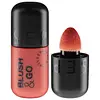What's inside
What's inside
 Key Ingredients
Key Ingredients

 Benefits
Benefits

 Concerns
Concerns

 Ingredients Side-by-side
Ingredients Side-by-side

Water
Skin ConditioningDimethicone
EmollientIsononyl Isononanoate
EmollientIsododecane
EmollientTridecyl Trimellitate
EmollientButylene Glycol
HumectantLauryl PEG-9 Polydimethylsiloxyethyl Dimethicone
Skin ConditioningVinyl Dimethicone/Methicone Silsesquioxane Crosspolymer
CI 77491
Cosmetic ColorantCI 77891
Cosmetic ColorantTrimethylsiloxysilicate
EmollientPhenyl Trimethicone
Skin Conditioning1,2-Hexanediol
Skin ConditioningCellulose
AbsorbentDisteardimonium Hectorite
StabilisingSodium Chloride
MaskingPhenoxyethanol
PreservativeMica
Cosmetic ColorantPolyhydroxystearic Acid
EmulsifyingEthylhexylglycerin
Skin ConditioningPropylene Carbonate
SolventSodium Dehydroacetate
PreservativeCI 77492
Cosmetic ColorantCI 77499
Cosmetic ColorantDimethicone/PEG-10/15 Crosspolymer
Triethoxycaprylylsilane
Tocopheryl Acetate
AntioxidantAluminum Hydroxide
EmollientDipropylene Glycol
HumectantSodium Citrate
BufferingTocopherol
AntioxidantWater, Dimethicone, Isononyl Isononanoate, Isododecane, Tridecyl Trimellitate, Butylene Glycol, Lauryl PEG-9 Polydimethylsiloxyethyl Dimethicone, Vinyl Dimethicone/Methicone Silsesquioxane Crosspolymer, CI 77491, CI 77891, Trimethylsiloxysilicate, Phenyl Trimethicone, 1,2-Hexanediol, Cellulose, Disteardimonium Hectorite, Sodium Chloride, Phenoxyethanol, Mica, Polyhydroxystearic Acid, Ethylhexylglycerin, Propylene Carbonate, Sodium Dehydroacetate, CI 77492, CI 77499, Dimethicone/PEG-10/15 Crosspolymer, Triethoxycaprylylsilane, Tocopheryl Acetate, Aluminum Hydroxide, Dipropylene Glycol, Sodium Citrate, Tocopherol
Hdi/Trimethylol Hexyllactone Crosspolymer
Cetearyl Ethylhexanoate
EmollientDimethicone
EmollientDicalcium Phosphate
AbrasiveSqualane
EmollientGlycerin
HumectantZinc Stearate
Cosmetic ColorantChondrus Crispus Extract
Skin ConditioningLauroyl Lysine
Skin ConditioningPolysorbate 80
EmulsifyingSilica
AbrasiveTin Oxide
Abrasive1,2-Hexanediol
Skin ConditioningEthylhexylglycerin
Skin ConditioningCaprylyl Glycol
EmollientPentaerythrityl Tetra-Di-T-Butyl Hydroxyhydrocinnamate
AntioxidantMica
Cosmetic ColorantCI 77891
Cosmetic ColorantCI 77491
Cosmetic ColorantCI 77492
Cosmetic ColorantCI 77499
Cosmetic ColorantCI 77000
Cosmetic ColorantCI 77163
Cosmetic ColorantCI 77400
Cosmetic ColorantCI 75470
Cosmetic ColorantCI 77289
Cosmetic ColorantCI 77288
Cosmetic ColorantCI 77510
Cosmetic ColorantCI 77742
Cosmetic ColorantCI 77007
Cosmetic ColorantCI 42090
Cosmetic ColorantCI 45370
Cosmetic ColorantCI 15850
Cosmetic ColorantCI 45380
Cosmetic ColorantCI 45410
Cosmetic ColorantCI 73360
Cosmetic ColorantCI 17200
Cosmetic ColorantCI 15880
Cosmetic ColorantCI 19140
Cosmetic ColorantCI 15985
Cosmetic ColorantHdi/Trimethylol Hexyllactone Crosspolymer, Cetearyl Ethylhexanoate, Dimethicone, Dicalcium Phosphate, Squalane, Glycerin, Zinc Stearate, Chondrus Crispus Extract, Lauroyl Lysine, Polysorbate 80, Silica, Tin Oxide, 1,2-Hexanediol, Ethylhexylglycerin, Caprylyl Glycol, Pentaerythrityl Tetra-Di-T-Butyl Hydroxyhydrocinnamate, Mica, CI 77891, CI 77491, CI 77492, CI 77499, CI 77000, CI 77163, CI 77400, CI 75470, CI 77289, CI 77288, CI 77510, CI 77742, CI 77007, CI 42090, CI 45370, CI 15850, CI 45380, CI 45410, CI 73360, CI 17200, CI 15880, CI 19140, CI 15985
 Reviews
Reviews

Ingredients Explained
These ingredients are found in both products.
Ingredients higher up in an ingredient list are typically present in a larger amount.
1,2-Hexanediol is a synthetic liquid and another multi-functional powerhouse.
It is a:
- Humectant, drawing moisture into the skin
- Emollient, helping to soften skin
- Solvent, dispersing and stabilizing formulas
- Preservative booster, enhancing the antimicrobial activity of other preservatives
Ci 77491 is also hydrated iron III oxide. It's sole purpose is to give a red/pink hue to products.
Iron III oxides are classified as inorganic chemicals for coloring.
Synthetically created Ci 77491 is considered safer than those naturally found. This is because the synthetically created version may contain less impurities. Iron oxides are generally non-toxic and non-allergenic.
Learn more about CI 77491Ci 77492 is also hydrated iron III oxide. It's sole purpose is to give a yellow hue to products.
Iron III oxides are classified as inorganic chemicals for coloring.
Synthetically created Ci 77492 is considered safer than those naturally found. This is because the synthetically created version may contain less impurities. Iron oxides are generally non-toxic and non-allergenic.
Learn more about CI 77492Ci 77499 is also hydrated iron III oxide. It is created from mixing red and black iron oxides. This helps give shades of darkness to a product.
Iron III oxides are classified as inorganic chemicals for coloring.
Ci 77891 is a white pigment from Titanium dioxide. It is naturally found in minerals such as rutile and ilmenite.
It's main function is to add a white color to cosmetics. It can also be mixed with other colors to create different shades.
Ci 77891 is commonly found in sunscreens due to its ability to block UV rays.
Learn more about CI 77891Dimethicone is a type of synthetic silicone created from natural materials such as quartz.
What it does:
Dimethicone comes in different viscosities:
Depending on the viscosity, dimethicone has different properties.
Ingredients lists don't always show which type is used, so we recommend reaching out to the brand if you have questions about the viscosity.
This ingredient is unlikely to cause irritation because it does not get absorbed into skin. However, people with silicone allergies should be careful about using this ingredient.
Note: Dimethicone may contribute to pilling. This is because it is not oil or water soluble, so pilling may occur when layered with products. When mixed with heavy oils in a formula, the outcome is also quite greasy.
Learn more about DimethiconeEthylhexylglycerin (we can't pronounce this either) is commonly used as a preservative and skin softener. It is derived from glyceryl.
You might see Ethylhexylglycerin often paired with other preservatives such as phenoxyethanol. Ethylhexylglycerin has been found to increase the effectiveness of these other preservatives.
Mica is a naturally occurring mineral used to add shimmer and color in cosmetics. It can also help improve the texture of a product or give it an opaque, white/silver color.
Serecite is the name for very fine but ragged grains of mica.
This ingredient is often coated with metal oxides like titanium dioxide. Trace amounts of heavy metals may be found in mica, but these metals are not harmful in our personal products.
Mica has been used since prehistoric times throughout the world. Ancient Egyptian, Indian, Greek, Roman, Aztec, and Chinese civilizations have used mica.
Learn more about Mica